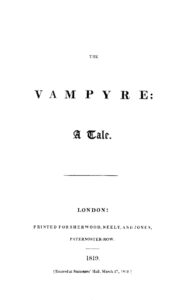Why Polidori’s The Vampyre was falsely attributed to Lord Byron.
One night in the rainy summer of 1816, at Lord Byron’s summer estate, Villa Diodati, in Cologny, near Geneva, Switzerland, Byron, and his friends Percy and Mary Shelley passed the time by telling ghost stories. The stories they created would lay the groundwork for future, publishable works. Perhaps most notable among these contributions was Mary Shelley’s, which she would turn into her opus Frankenstein; or the Modern Prometheus and publish approximately two years later.
This tale—of the assemblage of several of the Romantic movement’s most significant writers, all brainstorming hallmark contributions against the dreary, sublime backdrop of a stormy summer night—is specifically referenced in the preface to Frankenstein, which was written as Mary Shelley by her husband. “Two other friends,” Percy Shelley wrote of this night, after setting the scene: “(a tale from the pen of one of whom would be far more acceptable to the public than any thing I can ever hope to produce) and myself agreed to write each a story, founded on some supernatural occurrence.” The two friends, explains by D.L. MacDonald and Kathleen Scherf’s footnote in the Broadview critical edition of the novel, are certainly Percy Shelley and Lord Byron. Percy’s idea from that evening became, scholars believe, his “Fragment of a Ghost Story” (1816), and Byron’s idea was a spooky and inventive story about a vampire.
However, there was at least another guest there, that night—one who is left out of Shelley’s recapitulation, likely because he was unknown as a writer. This is Byron’s physician-in-residence, John William Polidori, who contributed a concept that would later become his novel Ernest’s Berchtold; or the Modern Oedipus. But this novel not his most notable literary achievement, however—Polidori wound up expanding Byron’s vampire concept (several paragraphs of which Byron had actually written), churning out his own different short work on the same topic, entitled The Vampyre, that same summer.
 Polidori left Cologny in September of that year, and left his manuscript with his friend Countess Catherine Bruce, who lived nearby. Two years later, a London publisher named Henry Colburn received a manuscript in the mail, containing “outlines” of several stories—the gothic exercises developed and written by Byron’s houseguests in Cologny, and, apparently Polidori’s whole manuscript. Bibliographer Henry R. Viets, who comprehensively researched the publication history of Polidori’s text, claims that it is unknown how this material precisely arrived in Colburn’s possession. The outline for Frankenstein was in this bundle, but it had already been published, so Coulburn discarded it, and instead published, in his periodical called New Monthly Magazine, The Vampyre, attributing authorship to Lord Byron. He arranged for publication of the story as a book, shortly after. Polidori was shocked, upon seeing The Vampyre published, and under Byron’s name. Byron denied writing it, but it was almost too late—the story (in the magazine) was a triumphant success, and at least one literary edition was on its way.
Polidori left Cologny in September of that year, and left his manuscript with his friend Countess Catherine Bruce, who lived nearby. Two years later, a London publisher named Henry Colburn received a manuscript in the mail, containing “outlines” of several stories—the gothic exercises developed and written by Byron’s houseguests in Cologny, and, apparently Polidori’s whole manuscript. Bibliographer Henry R. Viets, who comprehensively researched the publication history of Polidori’s text, claims that it is unknown how this material precisely arrived in Colburn’s possession. The outline for Frankenstein was in this bundle, but it had already been published, so Coulburn discarded it, and instead published, in his periodical called New Monthly Magazine, The Vampyre, attributing authorship to Lord Byron. He arranged for publication of the story as a book, shortly after. Polidori was shocked, upon seeing The Vampyre published, and under Byron’s name. Byron denied writing it, but it was almost too late—the story (in the magazine) was a triumphant success, and at least one literary edition was on its way.
Polidori began writing letters to the necessary parties to properly claim authorship, and soon, the edition which was already in the works from Sherwood, Neely, and Jones was published without Byron’s name—but without Polidori’s also. This is the edition of the text of Polidori’s The Vampyre that I first encountered in the Rare Book and Manuscript Library at Columbia University.
But Byron’s nebulous attachment to The Vampyre lived on. This anonymous edition of The Vampyre teased possible authorship by Byron (and if not, definitely affiliation with Byron) through its paratextual matter—namely an “Extract of a Letter to the Editor” in the front, which rehashes the gothic origin story told by Percy Shelley in the Preface to his wife’s book, and offers an explanation as to how this bundle of stories from this fateful night in Geneva came to be published; the unnamed “editor” simply says, “I obtained them as a great favor, and herewith forward them to you.” And the edition also features a piece by Bryon himself, an “Extract of a Letter, Containing an Account of Lord Byron’s Residence in the Island of Mitylene” in the back.
Assuming the text had been written by Byron and publishing it with paratexts that augment this is one matter—but deliberately concealing the true author while loading Byron into the frontmatter and backmatter is another, entirely. The Byron-heavy paratexts in The Vampyre, as well as the one in Frankenstein, treat Byron’s name as a brand—as a desirable label accounting for quality, and mastery of the genre at hand. The text comes to rely exclusively on these paratexts, when no author is listed.
This book, however, treated “Mary Shelley” as a brand, too, in light of the publication of Frankenstein. The end of “Extract of a Letter to the Editor,” lists the names of the Romanticists who brainstormed ghost stories; upon listing that Mary Shelley (as “Miss M.W. Godwin”—her name at the time) contributed a tale, this edition drops a footnote stating “since published under the title of Frankenstein: or the Modern Prometheus.” The Vampyre is in extra-good company, this footnote stresses. But this footnote also suggests another brand which further links thematically the paratexts in The Vampyre and Frankenstein—with a brand of teamwork, of Romantic collaboration. The texts produced that night are not most significant because they are independent products of some of the greatest writers of this significant literary movement, or because they can be associated with the great literary celebrity Byron, but because they were developed alongside one another—in accordance with the ideals of the Romantic movement, namely, inspiration.
The Vampyre tells the story of a young man named Aubrey—wistful, thoughtful, susceptible to wild fancies, and ever-appreciative of the beauty he sees around him—who befriends the rakish and enigmatic Lord Ruthven, who has a habit of making conquests of young women. Only after Aubrey travels to Greece, and his love, the beautiful (and knowledgeable about otherworldly creatures) Ianthe, is murdered by a vampire, does he begin to wonder if his friend is a monster—and he has this confirmed when Lord Ruthven is murdered by brigands, but nonetheless reemerges in Aubrey’s life a year later with a new name and the intent to marry Aubrey’s sister. The novel’s backmatter, the “Extract of a Letter, Containing an Account of Lord Byron’s Residence in the Island of Mitylene,” in addition to name-dropping “Byron” again, seems to play upon The Vampyre’s Greek setting—continuing the eerie romance of the Eastern Mediterranean world even after Polidori’s story has ended.
Many of The Vampyre’s characteristics suggest a deliberate attempt to recall another notable brand—that of Gothic/romanticism, in general. The “Introduction” to Polidori’s text is a historical survey of vampirism, citing several “historical” accounts of the subject as well as Romantic, literary acknowledgements—such as Byron’s poem “The Giaour” (a huge except of which is reprinted in this section), and Robert Southey’s poem “Thalaba.” The historical evidence helps ground the story of The Vampyre in spooky possibility, while the Romantic connections associate the story further with the conventions and ideologies of the genre.
Read more about the publication history of The Vampyre here.





